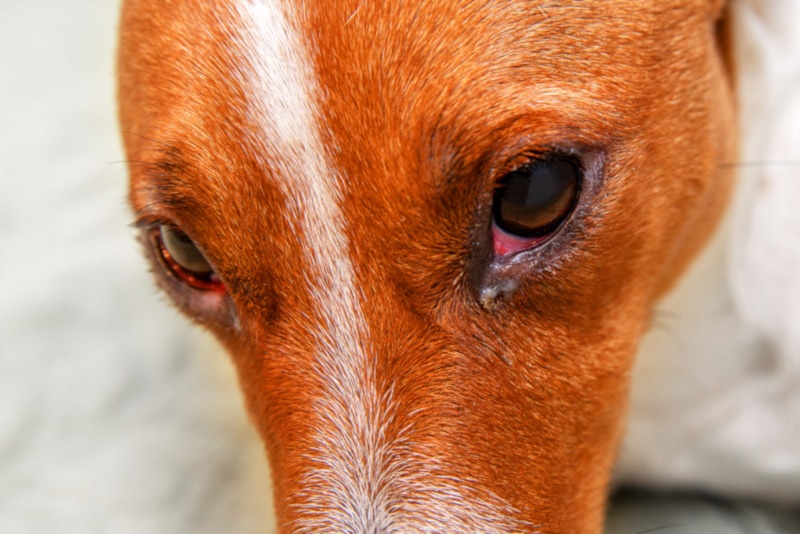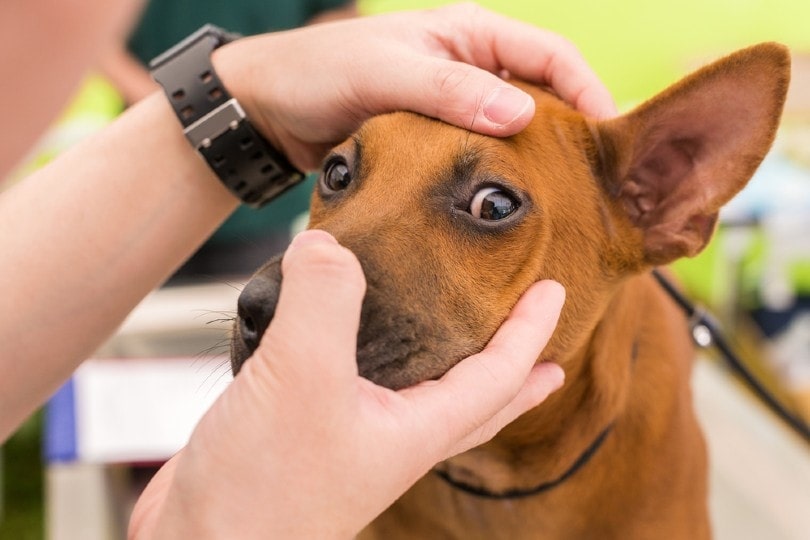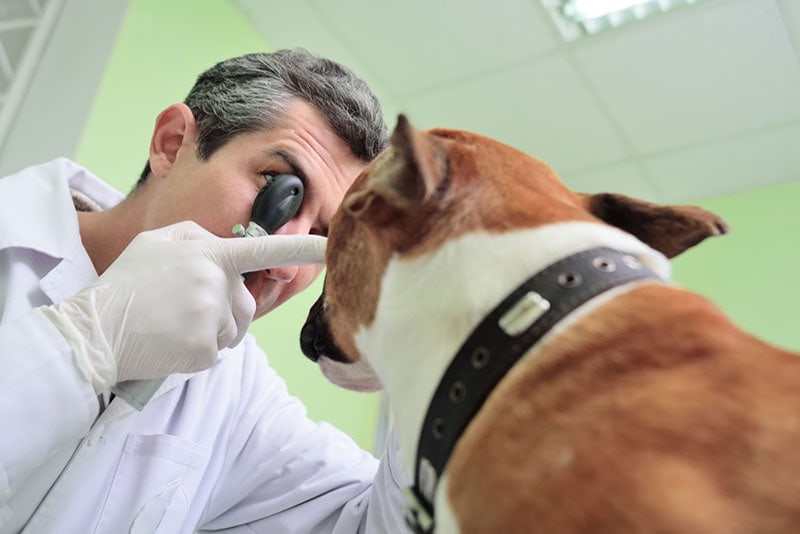Why Are My Dog’s Eyes Red? 13 Vet Reviewed Reasons & What To Do
Updated on

Click to Skip Ahead
You can learn a lot about a dog from their eyes. They can tell you when they are happy, scared, or in pain. Their eyes can even tell us a lot about their overall health. Sometimes, you may have observed redness in their eyes; this may be minor inflammation, but it can also be a sign of a more serious problem.
Many factors cause inflammation and redness in your furry friend’s eyes. It could be environmental irritants, allergies, dryness, eye injuries, entropion, or, even worse, a life-threatening medical condition. In extreme cases, your pup can also be at risk of partial or complete vision loss.
Thus, as a responsible pet owner, you must quickly detect the redness in your dog’s eyes to seek timely help. For your ease, we have listed common types of red eyes in dogs and their possible causes in this post. So, keep reading!
The 5 Types of Red Eyes in Dogs
Before we learn more about what red eyes might mean, we need to understand the different types of redness in the eyes. These generally refer to the area of the eye that is affected.
1. Episcleral Injection: Redness in the Whites of the Eye
Episcleral injection or episcleritis refers to redness in the sclera, the outer, white part of the eye. It occurs when the blood vessels in this region become congested.
This is an easily observable problem, and can be a response to environmental or topical irritation, but can also occur with more serious ocular issues like glaucoma (increased pressure in the eye).

2. Conjunctival Hyperemia: Redness in the Front and Inner Eye
The conjunctiva is the thin membrane surrounding the sclera around the inside of the eyelid. When this area is irritated, it becomes quite red and inflamed, which is called conjunctival hyperemia.
This type of redness indicates extraocular diseases, such as conjunctivitis, which affects the outside of the dog’s eyes.
3. Subconjunctival Hemorrhage: Redness Within the Eye Tissues
Subconjunctival hemorrhage refers to the redness in the deeper eye tissues present underneath the conjunctiva membrane. The inflammation is often caused due to trauma or clotting disorders.
This condition takes over the white part of the eyes, hiding the blood vessels completely.

4. Corneal Neovascularization: Redness on the Eye Surface
Dogs with defective cornea have corneal neovascularization, in which new blood vessels are formed on the eye’s surface. This condition is aresponse to damage to the corneal surface, indicating different inflammatory issues in the cornea, glaucoma, or uveitis.
- Affecting the long, branching vessels in the cornea, indicating superficial ulcerative or nonulcerative keratitis.
- Focal Deep. It targets straight, nonbranching vessels in the cornea, indicating deep corneal keratitis.
- 360° Deep. Appears as a narrow ring of vessels around the limbus (where the cornea meets the sclera). This is usually an indicator of a more diffuse ocular problem, such as uveitis (inflammation of the iris and vessels surrounding the eye) or glaucoma.
5. Hyphema: Redness in the Anterior Eye
Hyphema refers to blood pooling within the eye’s anterior chamber, which is the area under the cornea, over the iris and pupil. It can appear as complete redness (blood) covering the iris and pupil, or a blood pooled in the lower section of the chamber. Signs that may accompany hyphema include discharge from the eyes, third-eyelid inflammation, and intense swelling around the eyes.
Hyphema results from eye trauma, clotting disorders, or hypertension (high blood pressure).

The 13 Reasons for Red Eyes in Dogs
Now that you know the types of red eyes in dogs, it’s time to learn about the reasons for this condition. Here are the 13 most common factors behind your dog’s red eyes:
1. Allergies
Allergies are the primary reason for red eyes in dogs. Like humans, these pets are also allergic to dander or pollen, as they can make their eyes very itchy. The common signs indicating an allergy in your dog include the following:
- Frequent eye rubbing or scratching
- Inflammation
- Swelling in the conjunctiva and redness of the sclera
If your dog has chronic allergies, they may lose the hair surrounding their eyes. It’s tricky to treat allergies at home, so consult a vet when you observe any or all the above signs in your pet. The treatment of allergies depends on their root cause, but often includes oral medicines (antihistamines) and eye drops.

2. Conjunctivitis
Conjunctivitis results from any bacterial or viral infection, environmental irritants, or trauma. It can also be secondary to allergies. This condition causes intense inflammation and redness in your dog’s eye.
- Frequent squinting
- Redness in eyes
- Swollen conjunctiva
- A mucky or thick eye discharge
3. Keratoconjunctivitis Sicca (KCS)
Also known as dry eye, keratoconjunctivitis sicca is an autoimmune disorder in which the dog’s eyes produce little to no liquid tears. The condition dries up the pup’s tear glands, making their eyes prone to different injuries and trauma. These include abnormal scratching, irritation, and redness in the eyes. Nerve damage, hormonal issues, and drug side effects can be the causes of KCS, but it rarely happens.
This disease primarily affects Pugs, Cavalier King Charles Spaniels, American Cocker Spaniels, West Highland White Terriers, and Shih Tzus. If your dog belongs to any of these breeds, keep a strict eye on them. The common signs of KCS are:
- Dry eyes
- Sticky eye discharge
- Intense redness
KCS can be treated with topical medications for the eyes, and oral drugs to activate the dog’s immune system. Your vet will also recommend artificial tear eye drops to your pup to prevent dryness in their eyes.
Dogs with KCS will often be amazingly tolerant of the condition, but it is very uncomfortable; think of how horrible it feels to hold your eyelids open, letting your eyes dry out. If not managed properly, KCS can lead to corneal ulcers and other ocular complications.

4. Entropion
Entropion is when your dog’s eyelids roll inwards, causing their eyelashes to rub against the cornea. The condition can affect the lower or upper eyelids, or both, leading to intense irritation and redness in the pet’s eyes.
- Eye infections
- Swelling in the eyes
- Eye discharge
- Eye lashes that are wet and brushing against the surface of the eye
Entropion requires corrective surgery to be treated. If a dog doesn’t get medical attention on time, they may develop corneal ulceration.
5. Cherry Eye
Cherry eye, aka third eyelid (nictitans) gland prolapse, is when the gland in the dog’s third eyelid becomes inflamed and pushes upward to sit above the line of the lower eyelid, visible as a bulging area in the lower conjunctiva. It usually appears in dogs between 8 weeks to 3 months old, but may be younger or older. The gland may pop in and out, or be permanently displaced.
The actual causes of this condition are unknown. The breeds most affected by cherry eye include Shar Peis, Bullmastiffs, Great Danes, Pugs and French Bulldogs. If your dog belongs to any of these groups, you should look for the signs of cherry eye in them.
Mild cases of cherry eye may respond to eye drops that reduce inflammation. However, in severe cases, your dog will need surgery to put the gland back where it belongs.

6. Eye Injury or Trauma
Dogs are susceptible to many injuries and trauma when playing outside, especially with other dogs. Penetrating injuries are also possible, and sometimes foreign material, such as grass seeds or sticks, can become lodged in the conjunctiva surrounding the eye.
7. Corneal Ulcers
The cornea is the transparent, clear membrane covering the eye’s iris and pupil. A corneal ulcer is like a sore on the surface of the cornea, and can be superficial or deep. They can occur as a result of trauma, chronic irritation (eg. entropion), dry eye (KCS) or infection.
- A mucky eye discharge
- Excessive rubbing
- Squinting
- Aversion to bright light
- Depression
Brachycephalic breeds, particularly French Bulldogs, Pugs, Shih tzus, and Boxers are more prone to developing corneal ulcers than others because of the way their eyes protrude. This makes it difficult for the eyelids to properly cover and protect the cornea.
Corneal ulcers require immediate medical attention. It is possible for the ulcer to perforate the cornea in only 1 to 2 days. If not treated on time, it could lead to permanent vision loss, or even loss of the eye. Ulcers are often not visible to the naked eye, and need staining at the vet for diagnosis. If your dog shows any of the above signs, you must take them to the vet as soon as possible.

8. Glaucoma
Glaucoma occurs when the pressure in your dog’s eyeball suddenly increases. It happens when something damages the normal, healthy blood drainage in the eyes. This condition primarily occurs in breeds with genetic anatomical abnormalities, but can also be found in those with uncontrolled diabetes and cataracts.
Glaucoma can also develop from other underlying health issues, such as tumors, uveitis, lens luxation or damage, intraocular bleeding, or increased intracranial pressure. It can affect one or both eyes of the dog, causing the following changes:
- Cloudiness in the anterior chamber
- Episcleritis
- Larger or bulging eyeball
- Different pupil sizes
- Excessive tearing, redness, and squinting in the eyes
- Shying away and aversion to having their head touched
Your dog will need immediate medical care if they show any or all of the above signs. Severe cases of glaucoma can often lead to blindness, so take your pet to a vet as soon as possible. They may refer you to a veterinary ophthalmologist for a specific diagnosis and treatment plan.
9. Uveitis
- the iris: the colored part of the eye that controls the size of the pupil
- the ciliary body: structure in the anterior wall of the eye that makes the fluid that fills the eye
- the choroid: the middle layer of the eye that contains the major blood supply for the eye
Uveitis can be caused by infections, metabolic disease (eg. diabetes), hypertension, toxins (eg. chemicals getting into the eye), immune-mediated disease, trauma, lens damage, or tumors. Uveitis is very painful. The signs usually seen are:
- Excessive squinting
- Cloudiness or bluish haze on the eye’s surface
- Inflammation in the entire eye
- Depression
- Aversion to bright light.
Signs of uveitis should be treated as a medical emergency.

10. Skin Diseases
A dog’s eye can appear red not because of any issue within the eye but with their skin. Many skin-related issues like pyoderma, mange, and certain allergies, can cause the eye to become red and inflamed, and even lead to conjunctivitis.
This sort of eye problem will only resolve properly when the underlying skin condition is under control.
11. Blepharitis
Blepharitis refers to inflamed eyelids caused due to irritation, entropion, or allergies. It also happens when your dog’s lower eyelashes collect too much bacteria or the oil glands in their eyelids become irritated or clogged. Blepharitis causes intense redness in one or both eyes.
- Excessive itching around the eye
- Swelling in the base of the eyelashes
- Excessive rubbing on the face
- Squinting
Blepharitis puts your dog in extreme discomfort and pain. So, quickly take them to a vet quickly when they show any of the above signs. The treatment depends on the underlying cause but generally includes surgery or eye and oral medications.
12. Tumor
A dog’s eyes are susceptible to many benign (non-cancerous) or malignant (cancerous) tumors. While some can grow behind the eyes, others develop within it. One example is melanoma, which arises from uncontrolled melanocyte (pigment cells) growth. These are the cells present throughout a dog’s body.
Melanoma in the dog’s eyes can be of two types: uveal melanomas and limbal melanomas.
The uveal melanoma is the most common in dogs. It develops in the tissues of the uvea (the ciliary body, iris, and choroid). About 80% of uveal melanomas are non-cancerous but can be cancerous in rare cases.
On the other hand, limbal melanomas are relatively uncommon in dogs. They are completely non-cancerous and develop from the limbus, the border separating the sclera and the cornea.
Both uveal and limbal melanomas can cause redness in your dog’s eyes. Your pet may be rubbing or scratching their eyes frequently, which could lead to an infection or corneal ulceration. You may observe excessive discharge and tears in your puppy’s eyes because of the pain.
13. Hypertension
Lastly, your dog’s eyes can appear red due to increased pressure in their eye’s blood vessels. The smaller ones may rupture due to this stress, making their eyes look full of blood.
If you don’t seek timely help for your pet, they may become temporarily or permanently blind. A vet will recommend oral medications to manage your dog’s high blood pressure, which will ultimately resolve the redness in their eyes.

Red Eyes in Dogs: What to Expect from the Vet
At your vet’s appointment, the doctor will thoroughly assess your dog’s condition through different physical exams. They will also evaluate the pet’s medical history to identify the root cause of the issue.
The vet will also perform different laboratory tests such as a complete blood count, chemistry profile, urinalysis, and electrolyte panel. Eye-related tests may include the following:
- Schirmer Tear Test. It helps the vet measure your dog’s tear production levels to see if they suffer from dry eye or KCS.
- Fluorescein Stain. It enables the doctor to evaluate the dog’s eye surface and find any abnormal changes in the cornea, such as scratches. If there is a positive stain, the vet will diagnose it as a corneal ulcer.
- This test allows the vet to measure the dog’s intraocular pressure to check for uveitis or glaucoma.
Depending on your pet’s eye condition, the doctor may also perform advanced tests to identify the reason behind red eyes. They will include a complete ultrasound of the eye, CT scan, MRI, and blood pressure monitoring. Referral to an ophthalmology specialist is quite common with more serious eye conditions.
Virtually all cases of eye redness should be seen by your vet as a matter of urgency, because many eye problems can worsen rapidly. The exception would be in cases of mild allergy signs or mild conjunctival inflammation, provided your dog is comfortable and not rubbing the eyes excessively. In these cases, it might be sensible to observe your dog closely for 24-48 hours in case the inflammation resolves on its own.
Final Thoughts
Red eyes in dogs can occur due to many reasons. They can be mild allergies, environmental irritants, dryness, entropion, corneal ulceration, conjunctivitis, and cherry eye.
If you see your dog squinting, rubbing, and itching their eyes for many hours, you should take them to a vet for an urgent appointment. If not treated on time, the redness in your dog’s eyes can lead to permanent or temporary vision loss, so don’t ignore it, get it checked.
Featured Image Credit: Alexandr Jitarev, Shutterstock















